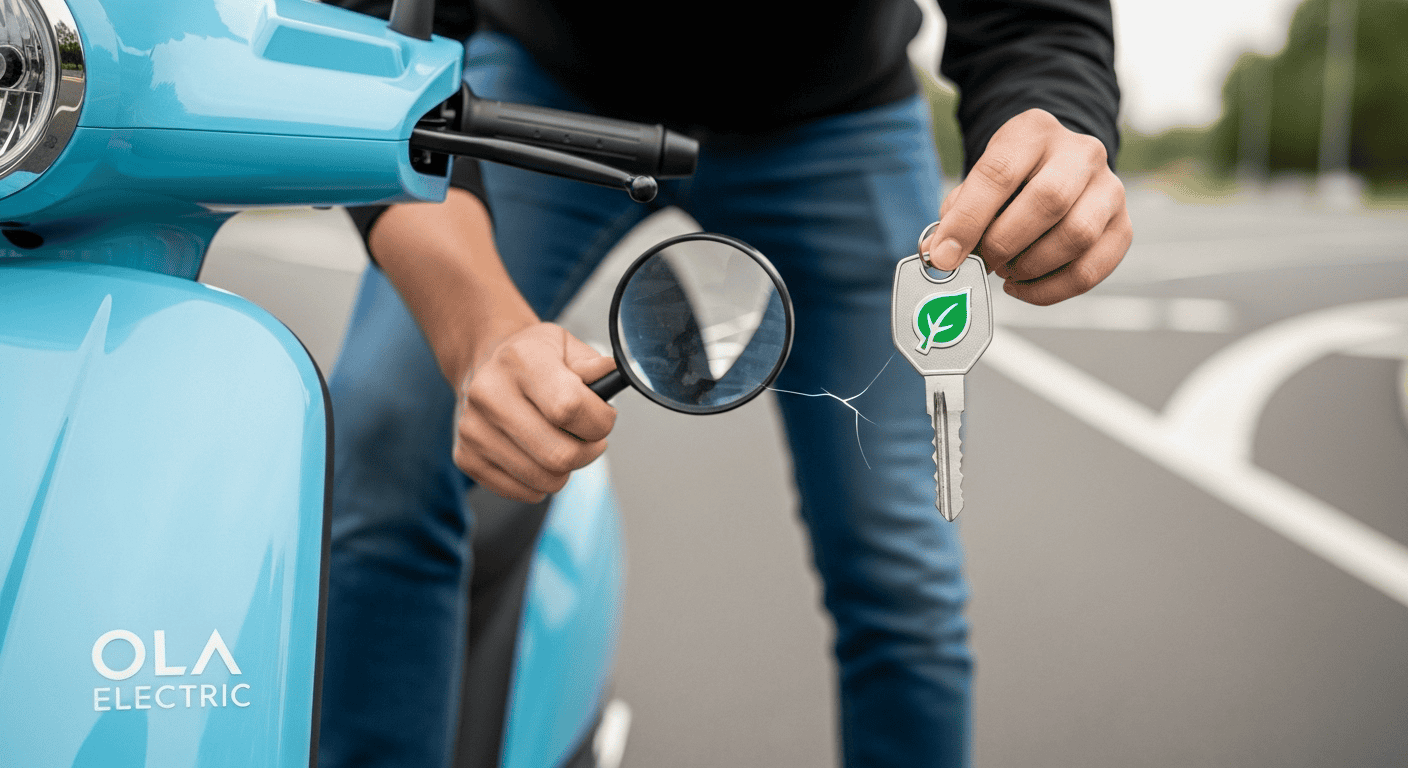Ola Electric: 7 Shocking Truths You Need to Know Before Buying
So, you’re captivated by the sleek design and futuristic promise of an Ola Electric scooter. You’ve seen the flashy ads, heard the buzz about India’s EV revolution, and maybe you’re tired of skyrocketing petrol prices. The idea of silently gliding through city traffic on a smart, eco-friendly machine is incredibly appealing. But before you pull the trigger and join the electric wave, we need to have a serious talk.
The Ola Electric story is a fascinating mix of groundbreaking innovation and troubling controversies. It’s a brand that has single-handedly accelerated EV adoption in India but has also left a trail of frustrated customers. Your interest is valid, but your desire for the full, unvarnished truth is what will save you from potential buyer’s remorse. This isn’t just about buying a scooter; it’s about investing in a new technology and a company that’s still navigating a very bumpy road. Let’s uncover the 7 shocking truths you absolutely must know.
The Unmatched Ambition vs. The Harsh Reality
At the heart of Ola Electric is a vision of massive scale, embodied by its colossal Future factory. The goal wasn’t just to build electric scooters but to dominate the market with unprecedented production capacity. This ambition is a huge part of the company’s appeal—they think big.
However, this rapid scaling has come with significant growing pains. The pressure to produce and deliver at speed has often clashed with the need for stringent quality control. Early adopters of the Ola S1 Pro, while wowed by its performance, frequently reported a host of issues ranging from software glitches and inconsistent panel gaps to more serious mechanical problems. The reality is that being an early customer of a company scaling this fast means you can sometimes feel like a beta tester for a product that’s still being perfected.
Performance That Thrills, and a Range That… Varies
There’s no denying it: the performance of the higher-end Ola Electric scooter models is exhilarating. The instant torque and rapid acceleration can leave traditional petrol scooters in the dust. On paper, the specs are a dream come true for tech and performance enthusiasts.
But then there’s the question of range—the single most important metric for many EV buyers. While Ola claims impressive numbers, the real-world range can be a very different story. It’s heavily dependent on riding style, terrain, payload, and even tire pressure. Many owners report achieving significantly less than the advertised range, especially when not riding in the power-limiting “Eco” mode. This discrepancy between claimed and actual range is a major source of customer dissatisfaction and a critical factor to consider for your daily commute.
What is the real-world range of an Ola S1 Pro?
While the certified range might be high, most users report a more realistic figure of 120-140 km on a full charge in Normal mode. Aggressive riding in Hyper mode can drop this figure dramatically. It’s crucial to align your expectations with these real-world numbers, not just the marketing claims.
The Software: A Double-Edged Sword
The large touchscreen dashboard and smart features are central to the Ola Electric experience. Navigation, music playback, and deep customization options make it feel like a smartphone on wheels. This is where Ola Electric truly sets itself apart from the competition.
However, software can be buggy. Users have faced a spectrum of issues, from unresponsive touchscreens and random reboots to phantom alerts and malfunctioning proximity unlock features. While Over-the-Air (OTA) updates can fix many of these problems, they can also sometimes introduce new ones. The reliance on software means you’re not just buying hardware; you’re buying into a software ecosystem that is still maturing.
The Achilles’ Heel: After-Sales Service and Support
This is perhaps the most significant and widely discussed issue plaguing Ola Electric. The company’s direct-to-customer model, which cuts out traditional dealerships, was meant to streamline the buying process. Unfortunately, it has created a nightmare for after-sales service.
Customers have reported horror stories of:
- Long Wait Times: Weeks or even months for service appointments and spare parts.
- Lack of Communication: Difficulty reaching customer support and getting clear updates on repairs.
- Inconsistent Service Quality: The expertise of technicians can vary wildly, leading to unresolved issues.
The Central Consumer Protection Authority (CCPA) has even stepped in after receiving thousands of complaints. While Ola Electric claims to be improving its service network, this remains the single biggest risk for a potential buyer. A fantastic scooter is useless if you can’t get it fixed in a timely manner. For more details on the scale of these issues, you can review reports from publications like The Economic Times, which have covered the challenges extensively.
Financial Health and Shifting Strategies
The financial journey of Ola Electric is a rollercoaster. The company has raised massive amounts of funding and successfully launched an IPO, yet it continues to face financial losses and a declining market share against strengthening legacy players like TVS and Bajaj.
Recent corporate restructuring, including raising funds internally between subsidiaries, as reported by outlets like Business Today, points to a company constantly adapting its financial strategy. As a buyer, the long-term health of the company is important for warranty support, future software updates, and the availability of spare parts. The company’s ability to navigate its financial challenges is directly tied to your long-term ownership experience.
The Ever-Expanding (and Confusing) Product Lineup
To cater to every possible price point, Ola Electric has launched a dizzying array of models and variants. From the high-end S1 Pro+ to the budget-friendly S1 Z and Gig, there’s a scooter for everyone. You can find a detailed breakdown of the latest models and prices on platforms like BikeWale.
This rapid expansion, however, can be confusing. Generations of scooters overlap (Gen 2, Gen 3), and the feature differences between variants like the S1 X and S1 X+ can be subtle but significant. It requires careful research from the buyer to understand exactly what they are getting. This strategy aims for market saturation but can also lead to a fragmented product experience and potentially impact the resale value of older models as newer, cheaper ones are introduced.
Is Ola Electric a good buy in 2025?
This is the million-dollar question. An Ola Electric scooter can be a fantastic purchase if you prioritize performance and technology and are willing to accept the potential risks associated with its after-sales service. It is less suitable for someone who values reliability and hassle-free ownership above all else.
The Vision of the Future: Batteries, Bikes, and Beyond
Despite the challenges, the vision of founder Bhavish Aggarwal remains incredibly ambitious. The company is investing heavily in its own battery cell technology at its Battery Innovation Centre to reduce reliance on imports and control the entire ecosystem.
Furthermore, the roadmap extends beyond scooters to include motorcycles like the Roadster series and even electric cars. This forward-looking vision is exciting and suggests that Ola Electric aims to be a dominant force in the global EV landscape. Buying an Ola is, in some ways, a bet on this future. The question is whether the company can fix its present-day problems to successfully deliver on its future promises.
Frequently Asked Questions
Q: Are Ola Electric scooters reliable for daily use? A: When they work, they are excellent for daily use, offering a low running cost and great performance. However, reliability is a concern due to software glitches and hardware issues reported by a significant number of users. The main issue is the unpredictability of after-sales service if a problem does arise.
Q: What are the main complaints against Ola Electric? A: The most common complaints revolve around poor and slow after-sales service, discrepancies between advertised and real-world range, numerous software bugs, and issues with build quality on some units.
Q: Is the battery covered under warranty? A: Yes, Ola Electric offers a warranty on its battery packs, with some models now coming with an 8-year warranty. However, customers have reported difficulties in getting batteries replaced under warranty, often facing long waits.
Q: How does Ola Electric compare to competitors like Ather and TVS iQube? A: Ola Electric often leads in raw performance, features, and aggressive pricing. Competitors like Ather Energy are generally praised for their superior build quality, more polished software, and, crucially, a much more reliable and responsive after-sales service network. TVS and Bajaj benefit from their vast, established service infrastructure.
Conclusion: A Revolutionary Product with a Risky Proposition
The Ola Electric scooter is not a simple “yes” or “no.” It is a product of duality. It is a glimpse into the future of urban mobility in India—fast, smart, and electric. It is also a cautionary tale of a startup growing at a breakneck pace, where the customer experience sometimes gets left behind.
If you are a tech-savvy early adopter who loves performance and is prepared to be patient with potential service issues, the Ola Electric S1 Pro could be one of the most exciting purchases you make. If you are a buyer who needs a completely dependable vehicle with a robust and accessible service network, you might want to wait or look at more established competitors.
The final decision rests on your tolerance for risk versus your desire for innovation. Do your research, read the latest customer reviews, and make a decision with your eyes wide open to both the brilliant promise and the shocking truths of Ola Electric.
#olaelectric #electricscooter #evindia #olas1pro #makinindiagreat
For more insights, visit TheFinGain.


